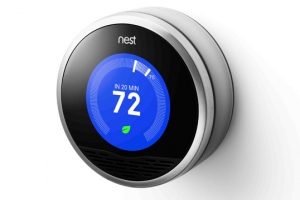forum
library
tutorial
contact

Utilities Embracing Smart Thermostats
to Help Manage Grids
by Katie Fehrenbacher
Giga Om, July 17, 2012
|
the film forum library tutorial contact |

|
Utilities Embracing Smart Thermostats
by Katie Fehrenbacher
|
 American utilities are slowly starting to embrace using smart thermostats to help manage the energy consumption of their customers. On Tuesday startup EnergyHub will announce that two Southern cooperative utilities will be offering EnergyHub's smart thermostat service to customers, after Texas energy service provider Reliant announced several weeks ago that it will be offering smart thermostat services from two Silicon Valley startups Nest and EcoFactor.
American utilities are slowly starting to embrace using smart thermostats to help manage the energy consumption of their customers. On Tuesday startup EnergyHub will announce that two Southern cooperative utilities will be offering EnergyHub's smart thermostat service to customers, after Texas energy service provider Reliant announced several weeks ago that it will be offering smart thermostat services from two Silicon Valley startups Nest and EcoFactor.
In a summer of record-breaking heat, and following an industry-wide trend of the power grid becoming increasingly digitized, utilities are looking for ways to both connect with their customers as well as better manage their customer's energy consumption. During hours of peak demand (like a hot summer day) a utility's electric grid can become impacted by too much energy use (picture everyone's air conditioner blasting). This can cause blackouts, or require expensive power from peaker plants.
The customers, on the other hand, can use the smart thermostats to reduce their energy consumption and save as much as 30 to 50 percent on their energy bills. Energy service providers like Reliant, which operates in a deregulated energy market in Texas, are also using these types of added services, like the Nest thermostat, to keep customers from signing up with competitors.
One of the earliest utilities to tap smart thermostats for energy management was Nevada utility NV Energy. NV Energy plans to provide 50,000 customers with a home energy dashboard from Control4 and a programmable thermostat. Another 50,000 are supposed to be signed up down the road. PG&E has also been piloting the smart thermostat service from Opower and thermostat maker Honeywell.
In EnergyHub's deal, the cooperative utilities Gibson Electric Membership Corporation and Mid-South Synergy will use the EnergyHub service, called Mercury, to reduce customers' heating and cooling consumption at times of peak demand. Utilities have long run services like this -- called demand response -- to reduce energy demand during high-impact hours, but the large majority of these programs have been run with commercial and industrial building owners and are also mostly done manually (instead of automatically via connected data networks).
Reliant, likewise, is using EcoFactor's smart thermostat management service to offer a similar type of demand reduction service to its customers. Reliant isn't using the Nest thermostat for demand response (yet).
All of these smart thermostat services -- from EcoFactor, EnergyHub, Nest and Opower/Honeywell -- enable utility customers to manage a wireless, connected thermostat using a cell phone or website. While EcoFactor and EnergyHub are focusing on the software side of the thermostat, Nest has created a well-designed thermostat that can learn from the user's behavior over several weeks.
Service providers like cable companies and telecoms are also offering these types of connected energy home tools. Comcast is offering a connected thermostat service from EcoFactor.
This is still an emerging service, but energy is becoming part of the smart home via both utilities and the data network providers. EnergyHub says it already has 100,000 smart thermostats under management and the company plans to add another 100,000 this year.
learn more on topics covered in the film
see the video
read the script
learn the songs
discussion forum
